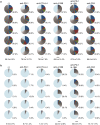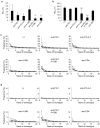Increased diversity with reduced "diversity evenness" of tumor infiltrating T-cells for the successful cancer immunotherapy
- PMID: 29348598
- PMCID: PMC5773695
- DOI: 10.1038/s41598-018-19548-y
Increased diversity with reduced "diversity evenness" of tumor infiltrating T-cells for the successful cancer immunotherapy
Erratum in
-
Author Correction: Increased diversity with reduced "diversity evenness" of tumor infiltrating T-cells for the successful cancer immunotherapy.Sci Rep. 2023 Apr 26;13(1):6816. doi: 10.1038/s41598-023-33836-2. Sci Rep. 2023. PMID: 37100847 Free PMC article. No abstract available.
Abstract
To facilitate the optimization of cancer immunotherapy lacking immune-related adverse events, we performed TCR repertoire analysis of tumor-infiltrating CD8+ T-cells in B16 melanoma-bearing mice receiving anti-PD-1, anti-CTLA-4, anti-4-1BB, anti-CD4 or a combination of anti-PD-1 and 4-1BB antibodies. Although CD8+ T-cells in the tumor were activated and expanded to a greater or lesser extent by these therapies, tumor growth suppression was achieved only by anti-PD-1, anti-PD-1/4-1BB combined, or by anti-CD4 treatment, but not by anti-CTLA-4 or anti-4-1BB monotherapy. Increased CD8+ T cell effector function and TCR diversity with enrichment of certain TCR clonotypes in the tumor was associated with anti-tumor effects. In contrast, polyclonal activation of T-cells in the periphery was associated with tissue damage. Thus, optimal combination therapy increases TCR diversity with extended activation of selective CD8+ T-cells specifically in the tumor but not in the periphery. Incorporation of the concept of evenness for the TCR diversity is proposed.
Conflict of interest statement
The authors declare that they have no competing interests.
Figures







References
Publication types
MeSH terms
Substances
LinkOut - more resources
Full Text Sources
Other Literature Sources
Molecular Biology Databases
Research Materials

